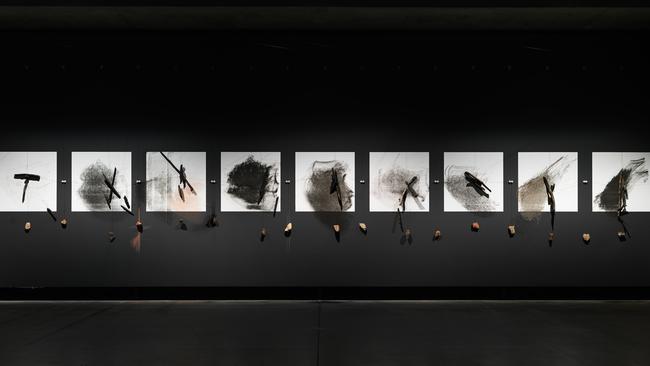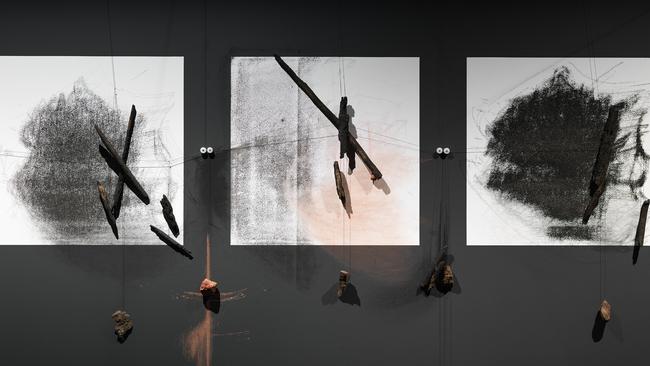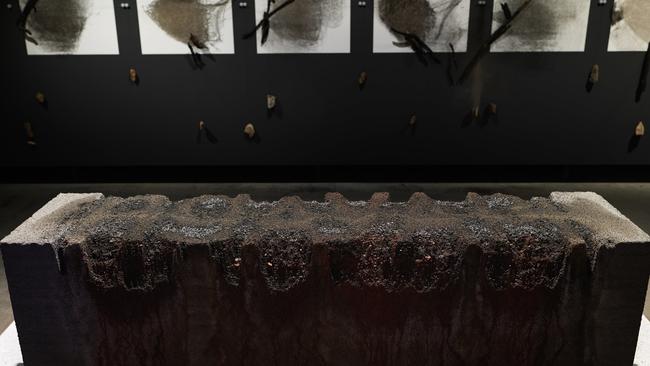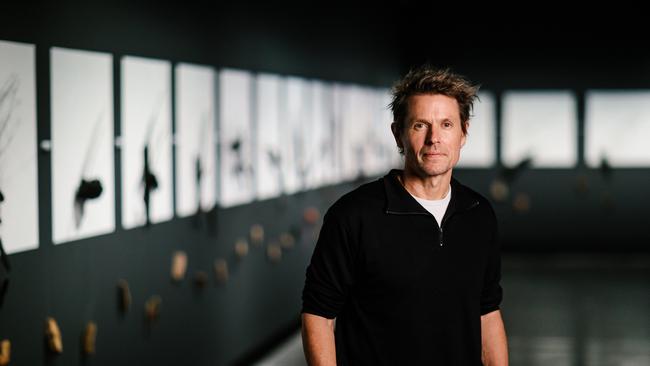MONA’s latest exhibition, meditation on identity
Robert Andrew is walking a line between two cultures – his Western and modern ancestry and his Indigenous roots.

Robert Andrew was one of the artists included in Ceremony at the National Gallery of Australia in Canberra, and like many others in that exhibition illustrates the complex and ambiguous position of contemporary Indigenous people, increasingly of mixed ethnic and cultural background, and trying to define a place for themselves between very different worlds.
Andrew is in fact one of the most extreme cases of this phenomenon, although by no means the only one.
He grew up in a middle-class family in Perth without any idea that he had Aboriginal ancestry, as he relates in detail in his doctoral thesis at the Queensland College of Art, which is available online. He even discusses the ideas that he had about Aborigines as a child – as a people entirely distinct from himself and his family.
Then it seems that one day his grandmother told him that her own grandmother had been Aboriginal, and showed him a photograph of her; thus Andrew turned out to have a great-great-grandmother who was Aboriginal, which is a fairly distant connection. To be precise, we all have 16 great-great grandparents, each of them representing a bit over 6 per cent of our genetic makeup.

His conclusion “I was therefore also Aboriginal” perhaps reflects his own feelings at the time; as he recalls, “At my young age, I could not relate to this heritage. I was disquieted as to how I fitted into the image of Aboriginal people that I had been taught through my formal education.” But it also recalls a very strange idea that seems to be uncritically accepted in Australia today: that if you have any Indigenous heritage at all you are somehow wholly Indigenous.
We don’t apply this logic to any other group; we don’t assume that someone who is partly Chinese, or German, or Hungarian is defined in some essentialist manner by this fractional component of their ethnic or national makeup.
Only in the case of Indigenous ancestry do we seem to accept a kind of racial mysticism that makes one particular genetic component decisive and all-defining.
Needless to say, this kind of thinking is dangerous because it is precisely the pattern that is familiar in racism: the idea that we are defined, confined and potentially damned by some special fraction of our background. It this logic that is fundamentally wrong and misguided, even if we try to switch the valorisation and make the fractional identity positive rather than negative.
Andrew is open about his own mixed background – since it is after all the whole premise of his work as an artist – although most website references to him call him an “Indigenous artist” or “a descendant of the Yawuru people”.
In reality he is engaged in what he himself sees as a kind of archaeological quest for the vestiges of his own past, long obscured by the passage of generations and a process of wilful forgetting.
Although his own Indigenous ancestors were in Western Australia and he now lives in Brisbane, it is not surprising that Andrew should have been drawn to Tasmania, where Indigenous traditions were brutally destroyed in the Black War almost two centuries ago (mid-1820s to 1832) and Truganini, the last full-bloodrepresentative of the original Tasmanians, died in 1876. This is consequently a place where all people who today still claim some ancestral connection to the old inhabitants of the island find themselves in much the same position as the artist himself.

Andrew’s relationship with the lost past is particularly through language, and here too Tasmania is an exceptional case. In other parts of Australia, sympathetic officers and administrators in the early days, and later especially missionaries, made word lists and studies of the native languages and sometimes even translated scriptures and other texts for the purposes of teaching and evangelisation.
In Tasmania, however, initial exchanges between Indigenous people and settlers were sparse, and the violent and tragic confrontation chronicled in Nicholas Clements’s recent book The Black War (2014), leading to the destruction of the Indigenous population through fighting and disease, occurred too early. There have been no native speakers of any Tasmanian language for well over a century, and very few records survive of any of these languages.
Nonetheless, the Tasmanian Aboriginal Centre began a project 30 years ago (1992) to reconstruct a language from the surviving fragments and traces of various different tongues once spoken in different parts of the island, and this has come to be known as Palawa Kani. The centre has apparently taken the unusual step of attempting to copyright this constructed language – unsuccessfully, because you can’t copyright a language – and also tried, 10 years ago, to have the Wikipedia page on Palawa Kani removed.
It seems that this attempt, also unsuccessful, was partly motivated by the conviction that the centre somehow owned the language, but also by a resistance to an objective and transparent account of how it was produced. This Wikipedia page – the source for much of my information on the subject – is well worth consulting, however, because the story of the attempt to reconstruct Palawa Kani is almost as quixotic as the project of bringing the Tasmanian tiger back from the dead.
For one thing the words that survive are from different language groups and many would never have been used together; the meanings of particular terms are undoubtedly ambiguous or uncertain in many cases; little is known about grammar and syntax; and even pronunciation is far from certain, because almost all the words attested are recorded in English approximations and may be about as accurate as the way Tommies and Diggers pronounced French place names in the Great War.
Renewing, updating and even reconstructing languages is a fascinating topic. Latin, for example, which only ceased being spoken in schools and universities in the past couple of centuries, is still kept up to date by an office in the Vatican. Modern Norwegian, as well as modern Greek after independence from the Ottomans 200 years ago, have both been through important modifications. The most extraordinary story of all, though, is that of modern Hebrew, which had not been a spoken language since before the time of Alexander the Great, and was renewed in the 20th century as the language of one of the most technologically advanced nations in the world. But Hebrew had the double advantages of already being a very sophisticated language with a long tradition of literacy, and of being the main language spoken by a very dynamic nation.
Palawa Kani words form the basis for three works in Andrew’s exhibition at MONA, although in each case the meanings of these words, and in two cases even the words themselves, are inaccessible to the viewer so that the show remains, at a more abstract level, a meditation on language and meaning.
One of these works seems at first to consist of a large black monolith. In the dim light, we realise that it is surrounded by small piles of sand and gravel, and then we realise that the top of the monolith has been worn away. A moment later, we understand that water dripping from a rig above is causing this erosion; the monolith is not as solid as it looks, but loosely compacted of sand, gravel, ochres – the various colours and textures revealed where the surface of the block has been worn away.
You have to stand back a bit, or look along the top at a raking angle, to see that the erosion is not random, but is slowly removing areas of the block to reveal a series of letters. We can’t yet read the word – or we couldn’t when I saw the work, which is obviously changing day by day – but we would not know what it meant even if we could. And of course the word that appears in this form would have been equally unintelligible to its original speakers, since they were pre-literate and unfamiliar with language symbolically represented in a visual form.
Above all, however, this work illustrates Andrew’s fascination with complicated and digitally-run machinery as the instruments of his archaeological project. The point is even clearer in the other and much bigger work that dominates the exhibition.
Three pieces outside the main room prepare us for a vast space filled with variations on the same theme. Sheets of paper are hung in a row around the room; in front of each hangs a small bunch of charred sticks, weighted below with a rock. At first everything seems still, but as we watch more closely we see the suspending strings tauten, and the bunch of charcoal sticks rises, falls, or moves from side to side.

As the charcoal moves, it marks the paper; apparently the movements are tracing, once again, words in the reconstructed version of the lost language. But because the instruments are so blunt and because the writing movement is repeated over and over again, no legible words emerge, only scribbles, tangles, clouds of dark shadow. There is something appropriate in this, for here too the mere transcription of the words is alien to the original language, let alone their transcription into the Latin alphabet. And so the resulting illegible scrawl is like the poetic image of a language spoken over and over again without ever being written down, read or transformed: like the blur of words merging, echoing dimly from centuries past.
And how is all this done? Once again by an intriguing combination of analog machinery and digital direction, which is all on display as part of the work. In the centre of the room is a steel frame within which all the wires that control the charcoal bundles on the four sides of the room are gathered into a single hub. As this hub moves around inside the steel frame, all the wires are drawn in one way or another; an ingenious system of miniature pulleys allows the wires to change direction as they are tightened or released.
It is significant that this mechanical device is so prominent, and indeed so much more intelligible and rational than the scrawls that result from its operation. The paradox of Andrew’s project becomes clear at this point, for it is his dominant Western and modern heritage that is expressed in the machinery he employs.
This really is Andrew’s world – the culture that is represented by the great majority of his ancestry and heritage – and it is through this culture that he seeks, poignantly, to make contact with, or perhaps to give some kind of rational account of, the ancient, obscure and almost vanished world of a tradition that makes up one thread of his background and, since his rediscovery of that thread, of his sense of being in the world.
Robert Andrew: Within an Utterance, MONA, until October 17.




To join the conversation, please log in. Don't have an account? Register
Join the conversation, you are commenting as Logout